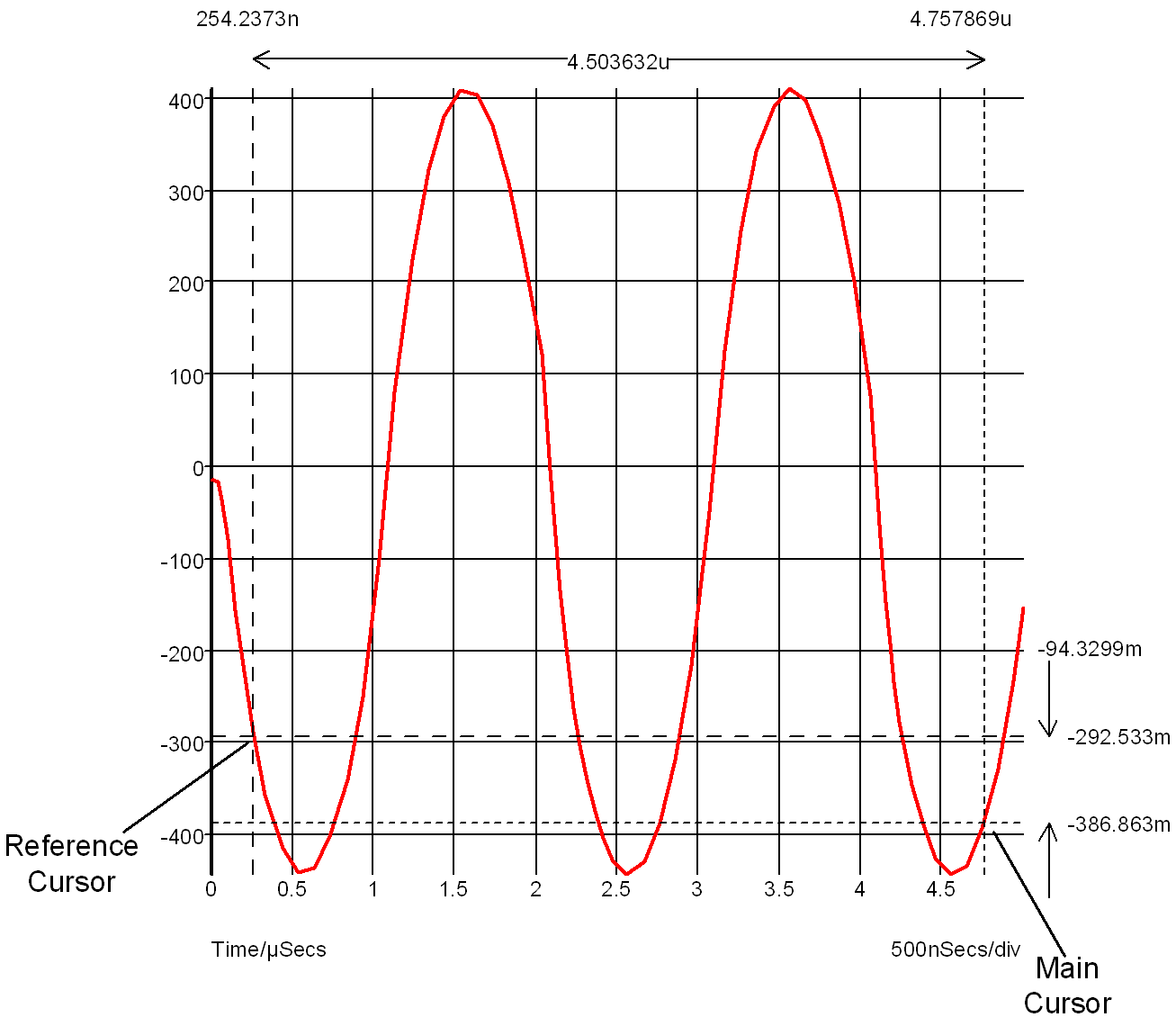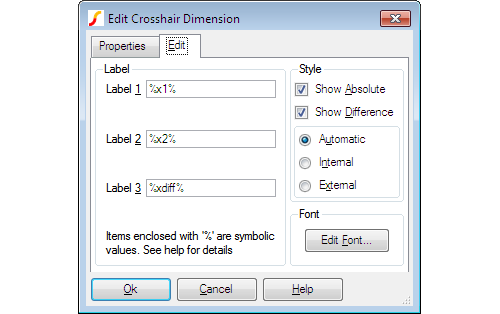

|
In this Topic Hide
Graph cursors can be used to make measurements from waveforms. In their default configuration they consist of two dimensioned crosshairs as shown below:

The cursors can be moved horizontally or vertically while tracking an attached curve or they can be picked up and dragged onto another curve.
Initially there are just two cursors, but there is the facility to add additional cursors without any maximum limit.
To switch on/off the cursor display select the graph menu
Cursors can be moved by a number of methods:
You can move a cursor to a peak or trough using the hot-key defined in the following table
| Key | Function |
|---|---|
| F5 | Move main cursor to next peak |
| shift-F5 | Move main cursor to previous peak |
| F6 | Move main cursor to next trough |
| shift-F6 | Move main cursor to previous trough |
| F7 | Move reference cursor to next peak |
| shift-F7 | Move reference cursor to previous peak |
| F8 | Move reference cursor to next trough |
| shift-F8 | Move reference cursor to previous trough |
You can temporarily hide all or some of the displayed cursors. Menu has a toggle action and will hide all cursors if all cursors are currently displayed and vice-versa. If some cursors are visible and some are hidden, you will be presented with an option to hide all cursors or show all cursors.
Menu allows you to selectively hide or show some cursors.
You can freeze the cursors so that they can't be moved accidentally. Select menu .
Select menu to align the two cursors so that they have the same y position.
SIMetrix has the ability to display any number of cursors, not just the standard two.
There are a number of options as to how the cursors' absolute and relative positions are displayed. Initially all values are displayed as dimensions on the graph. This can be altered in a number of ways:
Double click on one of the displayed values of the cursor dimension. The following dialog will open:

| Label |
The labels are the three values displayed on the dimension. Label 1 is the value displayed above the reference cursor, label 2 is the value displayed above the main cursor and label 3 is the value displayed as the difference. %x1%, %x2% and %xdiff% are symbolic values that will be substituted with the absolute position of the reference cursor, the absolute position of the main cursor and the difference between them respectively. You can add additional text to these. For example, if you changed label 1 to 'Pulse Start = %x1%' the value displayed for the position of the reference cursor would be prefixed with 'Pulse Start = '.
You can use expressions relating constants and symbolic values enclosed by '%'. Expressions must be enclosed in braces: '{' and '}'. For example, the expression {1/%xdiff%} will cause the difference value to be displayed as a reciprocal. This is useful if you wanted to display a frequency instead of a period. For a detailed description of this feature, see Graph Symbolic Values. You can use any arithmetic operator along with many of the functions described in the Script Reference Manual/Function Reference in these expressions. |
||||||
| Style |
Note, if you clear both absolute and difference, you will only be able to restore the display of the dimension by switching cursors off then on again. |
||||||
| Font | Select font used for readout text. | ||||||
| Properties Tab | Properties Tab The properties tab lists all available properties of the CrosshairDimension object. This will probably only be of interest if you are writing custom scripts to manipulate cursor dimensions. More information on this subject can be found in the Script Reference Manual/Applications/Grph Objects. |
You can optionally have the cursor read out in the status bar instead of or as well as the on-graph dimension display. Select menu and select option as required. This will change the current display.
You can opt to have this preference used as the default. Select menu then Graph/Probe/Data Analysis tab. Select appropriate option in Cursor readout section.
Note that the readout for additional cursors is always on the graph; there is no option to display in the status bar.
The menu will display in the command shell information about the curve which currently has the main cursor attached. The following information is listed:
| Curve name | |
| Source group | The name of the simulation group that was current when the curve was created. |
| Curve id | Only required when accessing curves using script commands. |
| Run number | If there are multiple curves generated by a Monte Carlo run, this is a number that identifies the run number that created the curve. This number can be used to plot the curve alone and also to identify the seed value used for that Monte Carlo step. |
There are four functions which return the current positions of the cursors and these can be used in script expressions. These are
See Script Reference Manual/Function Reference for details.
|